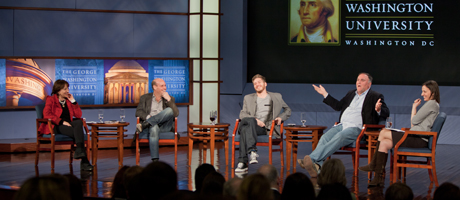By Menachem Wecker
“Should we make people eat their vegetables? Would that even work given what customers really like to eat?” asked food writer and blogger Jane Black.
Ms. Black, who was speaking in front of a sold-out audience at the Jack Morton Auditorium, was moderating a panel packed with local food experts: José Andrés, Todd Gray, Spike Mendelsohn and Nora Pouillon.
The panel, which was hosted by GW’s Urban Food Task Force, addressed a variety of issues from choosing between corn-fed and grass-fed beef to the relative merits of local food.
Diane Knapp, chair of the task force, introduced the program, Big Night, Big Jobs, and said that the conversation would address “creative cooking, healthy eating and the challenge of balancing those values with the desires and expectation of their customers.”
Those customer desires are very real, according to Mr. Mendelsohn, chef and owner of Good Stuff Eatery and We, The Pizza.
“I try to do as much as I can. If I were to use 100 percent grass-fed beef at my restaurant I’d be broke,” he said. “It’s really expensive to facilitate… I don’t think there are that many steak houses that don’t have corn-fed on the menu.”
Ms. Pouillon, chef and owner of Restaurant Nora, explained to the audience what the difference is between corn- and grass-fed cows.
Cows “are meant to eat hay grasses, and they get every good little juice out of these grasses,” she said. Cows can’t digest corn properly, so they have to be given antibiotics to prevent their stomachs from getting inflamed.
“That’s why I am not for corn-fed beef,” she said. “If they invent a corn that they can digest, that’s a different story.”
Mr. Gray, chef and owner of Equinox Restaurant and Todd Gray’s Watershed, said buying whole animals helps farmers, who need to move their meat quickly, and allows restaurants to offer a variety of prices on their menus by serving different cuts.
But to avoid being left with 200 pounds of ground meat, restaurants need to have a lot of freezer space. “Without the right facility and the right team in place, it can be difficult and you’re left with buying those premium cuts at premium pricing, and that’s challenging, for sure,” he said.
When Mr. Gray spoke about certain cuts of meat, he gestured toward corresponding parts of his body, which was not lost on Ms. Black.
“Do you ever notice the way chefs keep pointing to various parts of their body?” she said, “how it’s sort of freaky when they do that?” The audience and the chefs laughed, as they did often during the serious but personality-filled program.
Ms. Black then turned to Mr. Andrés, chef and owner of Café Atlántico, minibar by josé andrés, Jaleo, Zaytinya, Oyamel, The Bazaar, José Andrés Catering with Ridgewells, China Poblano and é by José Andrés.
Mr. Andrés critiqued the view that serving local food ought to be a priority for restaurants.
“I opened a restaurant that is from Spain, and I do Spanish cooking,” he said. “You’re going to come to my restaurant, a Spanish restaurant, and I’m going to send you cheese from Vermont? Well, you want to come to a Spanish restaurant or you don’t.”
What is required, Mr. Andrés said, is a “pragmatic” approach, or a middle ground.
“I cannot be in a room with someone that is telling me about localism in a very radical way and then their shoes are from China, their shirts are from Taiwan and their glasses are from Australia,” he said. “I’m like, ‘Listen. If you’re going to preach, preach completely or don’t preach.’”
The middle ground is to try to eat as much local food as one can, according to Mr. Andrés. “If I am a guy that lives in north Canada and I have to be eating local only, believe me, I will be a very sad person,” he said.
Other topics of conversation included contextualizing the removal of controversial items from the menu (farmers or fishermen lose jobs), discussing whether it’s hypocritical to speak to area children about the importance of best food practices that the chefs don’t practice exclusively (it is not; it’s about balance) and adding food to educational curricula, particularly in lower-income areas (“Only Jesus was able to multiply bread and sardines,” Mr. Andrés said).
At the end of the program, Ms. Black read a question from a student, who wanted to know what the chefs’ most embarrassing moments were. There were many, but one line from Mr. Andrés’ response, about how his children sometimes critique his menus, took the cake, so to speak.
“The best part is when they tell me, ‘Daddy, daddy, let’s go to McDonald’s. I heard they have a new burger. We need to do research,’” he said.


